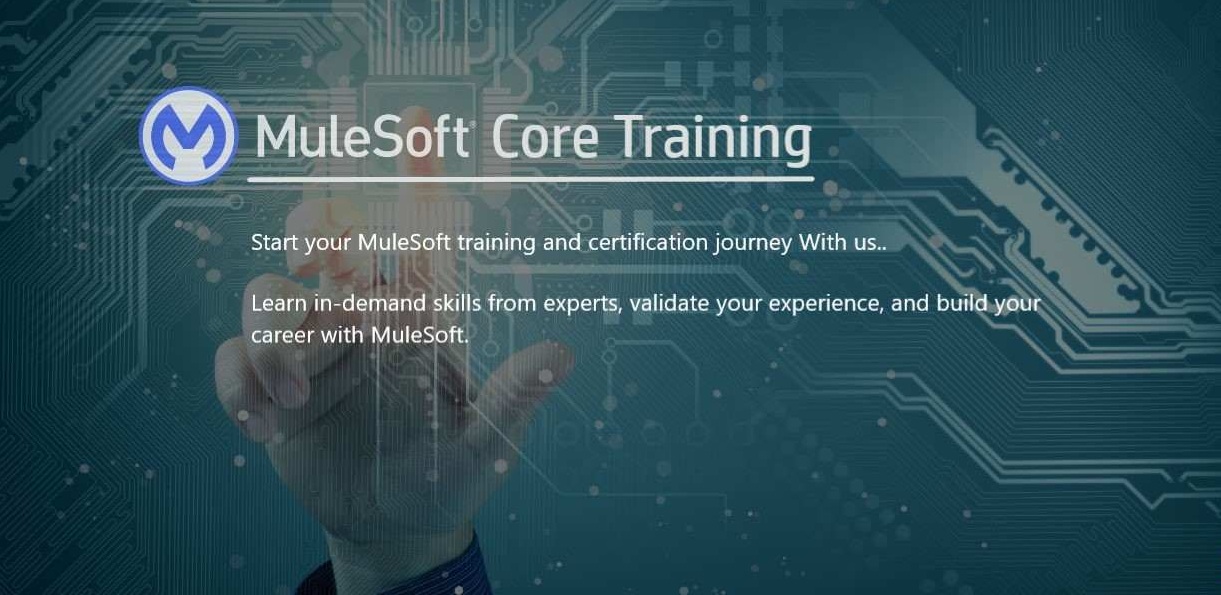MuleSoft Core Training

Course Description
This two-week course covers the advanced capabilities of MuleSoft with Anypoint Studio. This training Course offers the Participants a complete understanding of how to use MuleSoft to solve complex business orchestrations. Building upon the concepts and labs offered in MuleSoft Core Training, this training session looks closely at integrations, customizations, extensions, and error-handling. During the course, participants will have various activities and individual exercises that reinforce course topics.
Learning Objectives
At the end of this course, students should be able to:
-
Build an application network using API-led connectivity and Anypoint Platform.
-
Use the Anypoint Platform to discover, consume, design, build, deploy, manage, and govern APIs.
-
Connect to databases, files, web services, SaaS applications, JMS queues, and more.
-
Add application logic, handle errors, and transform data using DataWeave.
-
Structure applications to facilitate development and deployment.
-
Handle batch data processing.
Course Prerequisites:
-
A basic understanding of data formats such as XML, CSV, and JSON.
-
A basic understanding of integration such as HTTP, JMS, JDBC, REST, and SOAP.
-
An Anypoint Platform account.
-
OpenJDK 8 (not 11 or a later version).
-
Anypoint Studio 7.5.0 or later with embedded Mule 4.3 runtime.
-
A Salesforce Developer account (not a standard account) and API Access token.
-
Advanced REST Client (Postman/SOAPUI)
Course Structure
Explaining Application Network Basics
-
Explain MuleSoft’s proposal for closing the IT delivery gap
-
Describe the role and characteristics of the “modern API.”
-
Describe the purpose and roles of a C4E
-
Define and describe the benefits of API-led connectivity and application networks
-
Define and correctly use the terms API, API implementation, API interface, API consumer, and API invocation
-
Describe the basics of the HTTP protocol and characteristics of requests and responses
-
Describe the capabilities and high-level components of Anypoint Platform for the API lifecycle
Designing and Consuming APIs
-
Accessing and Modifying Mule Events
-
Structuring Mule Applications
-
Parameterize an application using property placeholders
-
Define and reuse global configurations in an application
-
Break an application into multiple flows using private flows, subflows, and the Flow Reference component
-
Specify what data (payload, attributes, variables) is persisted between flows when a Flow Reference is used
-
Specify what data (payload, attributes, variables) is persisted between flows when a Mule event crosses a connection boundary
-
Specify what data (payload, attributes, variables) exists in a flow before and after a call in the middle of a flow to an external resource
Building API Implementation Interfaces
-
Manually create a RESTful interface for a Mule application
-
Generate a REST Connector from a RAML specification
-
Describe the features and benefits of APIkit
-
Use APIkit to create implementation flows from a RAML file
-
Describe how requests are routed through flows generated by APIkit
Routing Events
-
Use the Choice router to route events based on conditional logic
-
Use the Scatter-Gather router to multicast events
-
Validate data using the Validation module
Handling Errors
-
Describe the default error handling in a Mule application
-
Define a custom global default error handler for an application and identify in what situations it will be used
-
Compare and contrast how the On Error Continue and On Error Propagate scopes work
-
Create one or more error handlers for a flow
-
Use the Try scope to specify error handlers for one or more event processors
-
Describe the data structure of the Mule Error object
-
Map errors to custom application errors
Transforming Data with DataWeave
-
Write DataWeave scripts to convert JSON, XML, and Java data structures to different data structures and data types
-
Use DataWeave functions
-
Define and use DataWeave variables, functions, and modules
-
Define and use custom data types
-
Apply correct DataWeave syntax to coerce data types
-
Apply correct DataWeave syntax to format strings, numbers, and dates
-
Call Mule flows from a DataWeave script
Using Connectors
-
Retrieve data from a Database using the Database connector
-
Create parameterized SQL queries for the Database connector
-
Retrieve data from a REST service using HTTP Request or a REST Connector
-
Use a Web Service Consumer connector to consume SOAP web services
-
Use the Transform Message component to pass arguments to a SOAP web service
-
List, read, and write local files using the File connector
-
List, read, and write remote files using the FTP connector
-
Use the JMS connector to publish and listen for JMS messages
Processing Records
-
List and compare and contrast the methods for processing individual records in a collection
-
Explain how Mule events are processed by the For Each scope
-
Use the For Each scope to process records
-
Explain how Mule events are processed by the Batch Job scope
-
Use a Batch Job with Batch Steps and a Batch Aggregator to process records
-
Use the Scheduler component to trigger a flow
-
Use connector listeners to trigger flows
-
Describe the features, benefits, and process to use watermarking
-
Describe the features, benefits, and process to use automatic watermarking vs. manual watermarking
-
Use connectors with automatic watermarking capabilities
-
Persist data between flow executions using the Object Store
Debugging and Troubleshooting Mule Applications
-
Use breakpoints to inspect a Mule event during runtime
-
Install missing Maven dependencies
-
Read and decipher Mule log error messages
Deploying and Managing APIs and Integrations
-
Package Mule applications for deployment
-
Deploy applications to CloudHub
-
Use CloudHub properties to ensure deployment success
-
Create and deploy API proxies
-
Connect an API implementation to API Manager using autodiscovery
-
Use policies, including client ID enforcement, to secure an API
-
Create SLA tiers and apply SLA based policies

